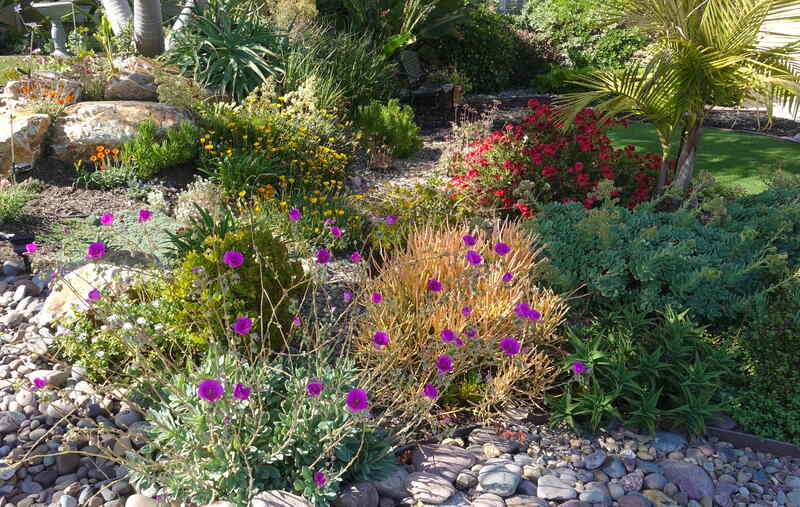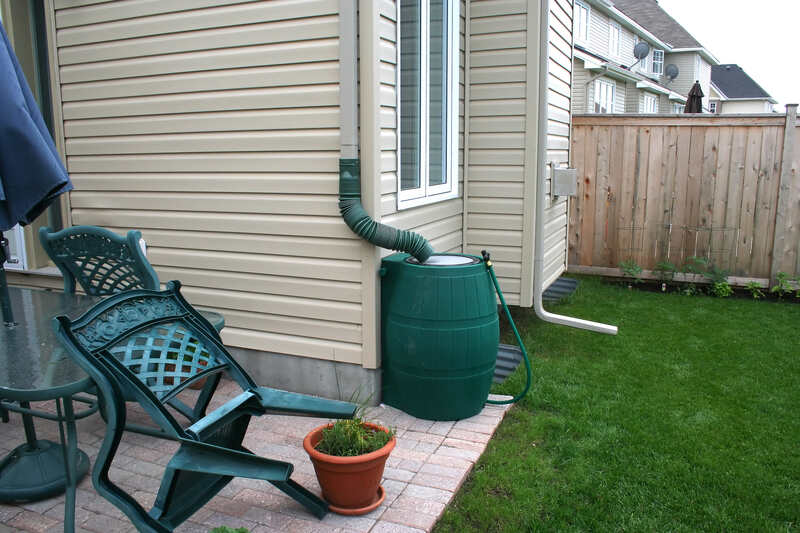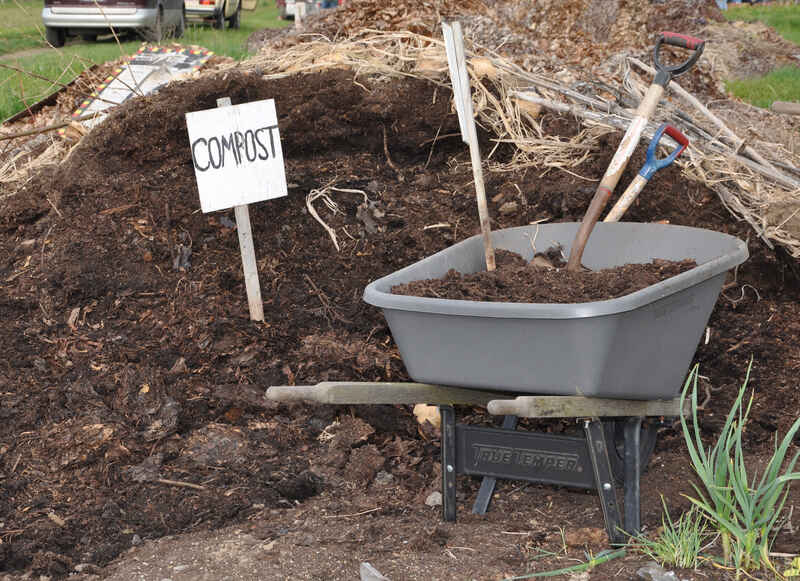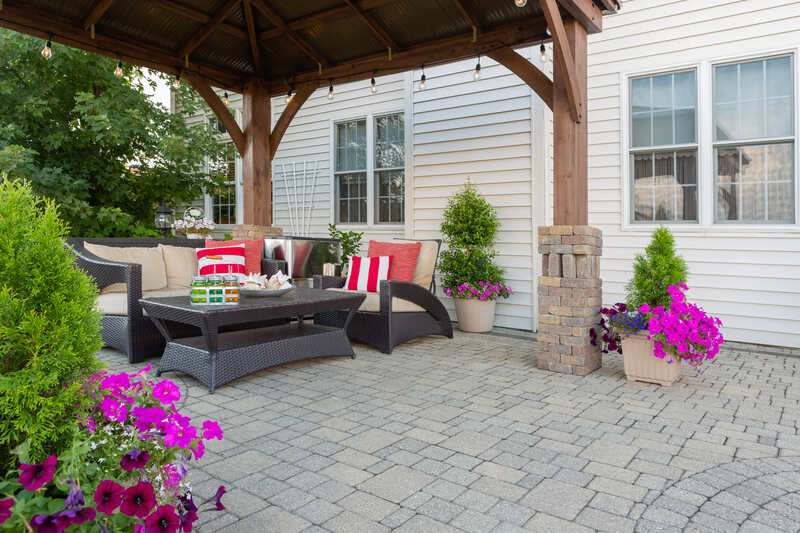
Trying to keep your grass green during droughts and city watering restrictions can be stressful. Instead of a traditional lawn, consider switching to a drought-tolerant landscape.
Drought-tolerant landscaping creates yards that can endure long dry spells by using drought-tolerant plants, efficient irrigation, mulching, and hardscapes. With advice from lawn care experts, learn the key elements you need for a drought-tolerant landscape.
What Does Drought-Tolerant Mean?
“Drought tolerant” refers to plants that continue to grow even in droughts. This is due to their ability to maximize how much water they absorb through their roots and minimize how much they lose through their leaves. After a certain point, though, they may go dormant or lose their foliage to survive.
Note: The terms “drought tolerant” and “drought resistant” are often used interchangeably, but drought-resistant plants are one step up from drought-tolerant plants and generally thrive in arid, low-water environments.
Key Elements of Drought-Tolerant Landscaping
Appropriate Plant Selection

When you’re in the market for drought-tolerant landscaping plants, “plants should be chosen based on their suitability to those landscapes,” says Abiya Saeed, Extension horticulture specialist at Montana State University.
Saeed recommends considering these factors for drought-tolerant plants:
- Cold hardiness zone
- Soil type and texture
- Availability of nutrients in soil
- Sun and shade requirements
- Space needed for mature plants
Here are common characteristics of drought-tolerant plants:
- Roots grow deeply
- Small leaves or needles
- Waxy or hairy leaves
- Gray or silver leaves
- Can go dormant during droughts
Saeed advises homeowners to contact their local Extension office to help determine which drought-tolerant plants would be suitable in their yard. If you’d rather leave plant selection to someone else, find a professional landscape designer to create a drought-tolerant landscaping plan for you.
Drought-Tolerant Plants
Don’t think that installing drought-tolerant plants in your yard limits you to only succulents and cacti. You can plant all kinds of plants in a drought-tolerant landscape:
- Drought-tolerant trees
- Drought-tolerant grasses
- Ornamental grasses
- Drought-tolerant ground covers
- Drought-tolerant shrubs
Succulents are a common choice for drought-tolerant landscapes and can be grown in outdoor containers, rock gardens, and well-draining sandy soil. Succulents’ fleshy leaves and stems store plenty of water, so they often don’t need much more than rainfall once established.
Native Plants
The native plants in your region are often naturally water-smart for a few reasons:
- Many native plants grow deeper roots than non-native plants. This allows plants to access more water.
- They’re adapted to thrive in the climate conditions of your hometown.
- They won’t require much watering aside from rainfall once established as long as you install them in ideal sun and soil conditions.
Looking for good native plants for your drought-tolerant landscape? Check out a few of our native plant guides below. Then search on our blog for native plants in your state:
Specialized Root Structures
The genetic makeup of drought-tolerant plants allows them to grow deep root systems as long as they receive enough water during the establishment phase. These root systems take in as much water as possible.
Efficient Irrigation Systems

Drip Irrigation
Drip irrigation is an ideal watering method for landscape beds. It reduces water use (less overspray) and water loss (less evaporation) by delivering moisture directly to the roots of the plant.
See Related:
Smart Irrigation Controller
To determine when your landscape needs more water, smart irrigation controllers are automated devices that measure certain environmental factors, such as:
- Temperature
- Precipitation
- Humidity
- Wind speed
- Weather conditions
- Evapotranspiration
- Soil moisture levels
With this information, smart irrigation controllers adjust watering amounts to your landscape’s needs. This cuts back on overwatering your lawn and reduces water waste.
Rainwater Harvesting

Collect rainwater runoff in a rain barrel. Later, you can use that water to irrigate landscape plants. Recycling rainwater is environmentally friendly because it conserves valuable water resources and prevents stormwater runoff pollution.
See Related: Rainwater Harvesting Restrictions and Incentives by State
Proper Scheduling
Here are some water scheduling strategies that reduce water waste:
- Hydrozoning: Group plants with similar watering needs together. This way, you can irrigate plants in a designated area with only what they need.
- Mow in the morning or evening: Never water in the heat of day. The best time to water is between 5 a.m. to 9 a.m. The second-best time to water your yard is in the evening, around 6 p.m.
- Water only 2-3 times a week: Watering deeply is better than watering frequently. Your lawn needs about 1 inch of water a week.
See Related: How Often Should I Water My Lawn?
Soil Health
Organic Matter

When soil is rich in organic matter, it retains moisture longer. “Organic matter will hold moisture when it does rain (or when irrigation is applied),” says Susan Barton, professor and Extension specialist at the University of Delaware.
Here are the types of organic matter you can add to your soil to improve it:
- Compost
- Chopped leaves
- Finely shredded bark
- Rotted manure
- Straw
Mulch
A layer of mulch insulates landscaping plants. Mulch traps moisture and keeps the soil cool, preventing soil from losing water quickly in hot temperatures.
Mulching is inexpensive and also prevents weeds in flower beds and reduces erosion. Organic mulch also adds nutrients to the soil and plants over time.
| Hire a LawnStarter landscaping pro to mulch your yard. Our customers spend around $286 per mulching service and give our pros an average rating of 4.7. |
See Related:
Thoughtful Hardscaping

Hardscapes add an elegant flair to your yard and provide recreational areas to hang out with family and friends.
Consider adding hardscapes to your lawn to reduce the amount of grass and water use in your yard:
When you install a hardscape, your lawn must have proper grading so that your yard doesn’t develop drainage problems or soil erosion issues. Hardscapes that don’t dry efficiently and retain moisture may deteriorate prematurely, causing cracks or other damage.
Also, think about how or if you’ll want to incorporate plants around your new structures. For example, terracing with retaining walls may be a better idea than simply placing mulch on a slope and adding plants. “Anything planted on a hill will lose water more quickly,” says Barton.
See Related:
How Drought-Tolerant Landscaping Differs From Traditional Landscaping
Traditional landscaping includes turfgrass lawns and plants that typically require a lot of water.
On the other hand, drought-tolerant landscapes are capable of surviving droughts with low amounts of water. Drought-tolerant landscapes minimize areas of turfgrass and swap them out for hardscapes or water-efficient landscapes.
| Drought-Tolerant Landscaping | Traditional Landscaping | |
| Water Usage | Low | High |
| Plant Selection | Plants are limited to drought-tolerant and native plants | Any type of grass and plants |
| Maintenance | Low maintenance | High maintenance |
| Soil Management | May need soil amendments | May need soil amendments |
| Environmental Impact | Conserves water by up to 60% | Wastes water |
Why Choose Drought-Tolerant Landscaping?
Drought-tolerant landscaping is a smart idea for your yard for many reasons. Here are the benefits of a drought-tolerant landscape:
- Saves money. Reducing the need for water in your yard means you won’t have to spend as much to keep it green.
- Saves time. Imagine the hours you’ll get back that you otherwise would have spent standing outside with a hose!
- Less maintenance. Low-maintenance drought-tolerant landscapes require less mowing, fertilizing, watering, seeding, and weeding than traditional lawns.
- Fewer pesticides. Drought-tolerant landscapes don’t need as many pesticides, which is eco-friendly and saves you from spending your hard-earned money on chemicals.
- Stays cool in the summer and warm in the winter. A well-planned drought-tolerant landscape increases shade in hot weather. In the winter, it shields your home from cold winds.
- Improved curb appeal. Drought-tolerant landscaping increases curb appeal during drought conditions, particularly in severe droughts when local ordinances limit water use.
- Less soil erosion. Drought-tolerant landscaping reduces soil erosion and stormwater runoff.
- Eco-friendly. It reduces water waste and removes pollutants and carbon dioxide from the atmosphere.
More and more states are implementing water restrictions, so switching to a drought-tolerant landscape will help protect the environment and save you from worrying if your yard will survive local water restrictions.
FAQ About Drought-Tolerant Landscapes
The amount of water you will save with drought-tolerant landscaping depends on how extensively you remodel your lawn. Colorado Waterwise reports that it is possible to reduce outdoor water usage up to 60% with a drought-friendly landscape, which will significantly decrease your water bills.
In the long-term, drought-tolerant landscaping is cheaper than traditional landscaping since it will reduce your costs on watering, mowing, weeding, pesticides, and more. However, depending on the project, upfront costs for installing a drought-tolerant landscape can be expensive.
Here’s a sampling of the landscaping costs you might encounter:
• Drip irrigation cost: $1.70 to $4.80 per square foot installed
• Mulch cost: $192 to $402 per cubic yard installed
• Retaining wall cost: $3,500 to $9,400 installed
Xeriscaping takes drought-tolerant landscaping a step further. Xeriscaping involves replacing some or most of the grass with rocks, mulch, walkways, and drought-tolerant or drought-resistant species.
See Related:
Install a Drought-Tolerant Landscape
Even in droughts when water is scarce, a drought-tolerant landscape can survive. Maintain a regular watering schedule and use water-wise irrigation methods to conserve water and to cultivate a drought-tolerant landscape.
If you want to switch to a drought-tolerant landscape, find a local landscape designer to help you choose drought-friendly plants and redesign your landscape.
Read More: How to Take Care of Your Lawn During a Drought
Sources:
- Abiya Saeed, Extension horticulture specialist at Montana State University, Bozeman, MT. Personal interview.
- “Drought Tolerant Plants.” By Kelly Feehan, Extension educator. University of Nebraska-Lincoln.
- “Drought-Tolerant Plants Save Water, Money and Time.” Michigan State University.
- “Drought Tolerant vs. Drought Resistant Gardens.” By Flo Pucci, master gardener. University of California Agriculture and Natural Resources.
- Susan Barton, professor and Extension specialist at the University of Delaware, Newark, DE. Personal interview.
- “Xeriscape Colorado.” Colorado WaterWise.
Main photo credit: My little succulent garden / Flickr / Public Domain